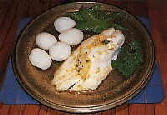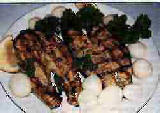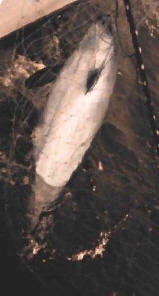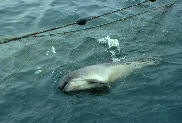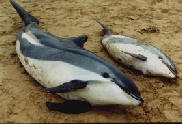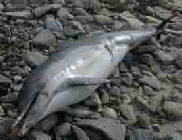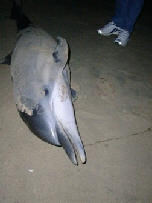EUROPEAN CETACEAN BYCATCH CAMPAIGN
"Man is but a strand in the complex web of life"
"Man is but a strand in the complex web of life"
TOO HIGH A PRICE TO PAY FOR A PIECE OF FISH
" To the Dolphin alone, beyond all other, nature has granted what the best philosophers seek: friendship for no advantage"
Plutarch
Plutarch
The European consumer is continually reminded by the fishing industry that fish is a relatively inexpensive source of protein.
In monetary terms, this is probably correct, given that porpoise, dolphins and whales have no market value in most European countries.
However, love, happiness, health and family have no market value, and yet these are perhaps the most valuable gifts of all.
The European Cetacean Bycatch Campaigns believes that the deaths of tens of thousands of intelligent, beautiful, and gentle mammals is too high a price to pay for protein.
Perhaps when you have read the following information, you will agree with us.
Harbour Porpoises.
Studies have estimated that the annual bycatch of harbour porpoises in the Celtic Sea hake gillnet fishery, is of the order of 2237 individuals.
In 1998, when only 238 hauls of the English bottom set gillnet fishery in the Celtic Sea were observed, there was a bycatch of 16 harbour porpoises, 7 of which were caught in nets with pingers.
In total 6.2% of the total population of harbour porpoises in the Celtic Sea is killed each year in fishing nets.
It is estimated that 7000 harbour porpoises are caught in Danish North Sea gillnet fisheries each year, and 1000 in the UK North Sea gillnet fisheries. This amounts to 4% of the total population of harbour porpoises in the North Sea.
The International Whaling Commission has stated that a continual kill rate of only 1% of a cetacean population should be cause for concern and investigation should take place as a matter of priority (IWC 1995).
In the Skagerrak it is estimated that 110 porpoises are caught in the Swedish cod gillnet fishery each year.
In addition countless porpoises die due to entanglement in gill nets in other sea areas other than those mentioned.
Many scientists are of the opinion that many also die in the nets of purse seiners and pelagic trawlers.
January – February 2002: There was an alarming increase in the number of porpoises stranding on the beaches of Southern England, many of which had no head or tail flukes. The vast majority showed signs of entanglement in nets.
Dolphins.
Studies have estimated that the annual bycatch of common dolphins in the Celtic Sea hake gillnet fishery is 200 at least.
There are no estimates available for Danish North Sea gillnet and UK North Sea gillnet fisheries, but scientists suggest that the number must be in the hundreds.
Available scientific papers suggest that potentially high numbers of common, white-sided, striped and bottlenose dolphins are being killed in trawl fisheries each year, in the northwest and the northeast Atlantic, the Western Approaches, the English Channel, in Swedish, Danish and German waters and in the waters off northwest Ireland.
The highest dolphin mortalities are due to entanglement in the nets of pair trawlers.
Morizur et al (1997) suggested that up to 50 dolphins may be taken in a single haul of a pelagic trawl.
In a recent study of the UK seabass pair trawler fishery, 20 dolphins were taken in a single haul of a pair trawler.
During a study of the Irish tuna pair trawl fishery, 4 pairs of trawlers were monitored.
In only 313 hauls, a total of 145 cetaceans were taken – 127 common dolphins, 8 striped dolphins, 2 Atlantic white-sided dolphins and 8 pilot whales.
30 cetaceans were taken in a single haul.
It is estimated that during the months January – March this year, 4 000 – 10 000 dolphins died due to entanglement in the nets of pair trawlers fishing in the English Channel / Western Approaches.
The countries using this method of fishing in the Western Approaches are Scotland, England, Ireland, France, Denmark, and the Netherlands.
There are no estimates available for Danish North Sea gillnet and UK North Sea gillnet fisheries, but scientists suggest that the number must be in the hundreds.
Available scientific papers suggest that potentially high numbers of common, white-
The highest dolphin mortalities are due to entanglement in the nets of pair trawlers.
Morizur et al (1997) suggested that up to 50 dolphins may be taken in a single haul of a pelagic trawl.
In a recent study of the UK seabass pair trawler fishery, 20 dolphins were taken in a single haul of a pair trawler.
During a study of the Irish tuna pair trawl fishery, 4 pairs of trawlers were monitored.
In only 313 hauls, a total of 145 cetaceans were taken – 127 common dolphins, 8 striped dolphins, 2 Atlantic white-
30 cetaceans were taken in a single haul.
It is estimated that during the months January – March this year, 4 000 – 10 000 dolphins died due to entanglement in the nets of pair trawlers fishing in the English Channel / Western Approaches.
The countries using this method of fishing in the Western Approaches are Scotland, England, Ireland, France, Denmark, and the Netherlands.
